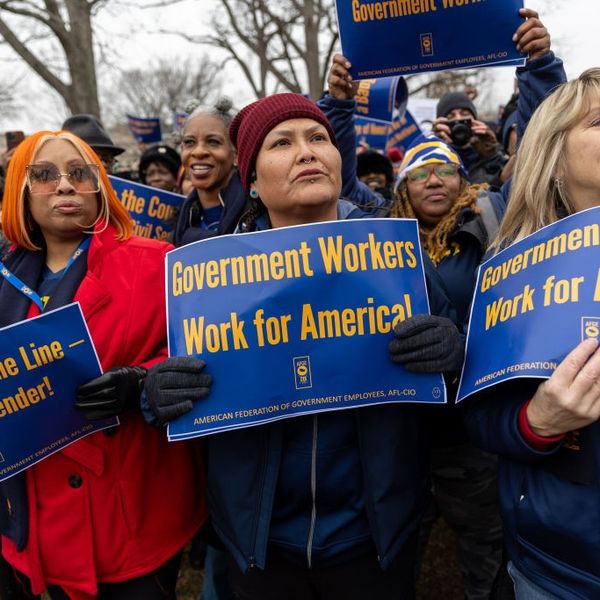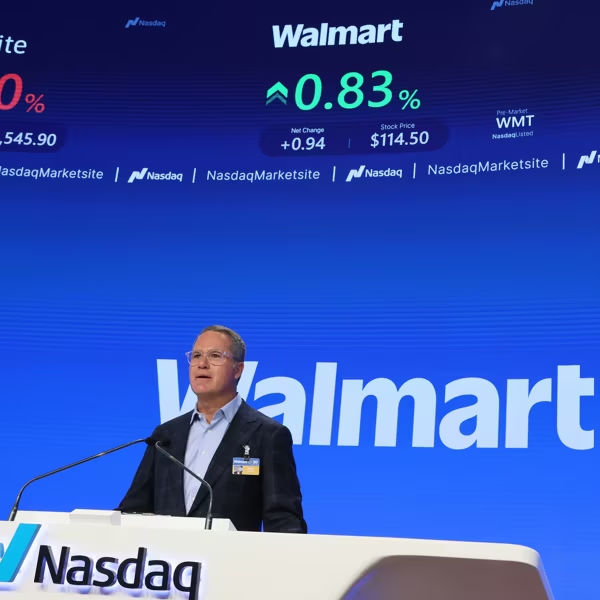New Labor Stats Show Assault on Public Unions Is Working
Numbers 'reflect concerted attack on organized labor'
As the Washington Post's Jim Tankersley points out and new data from the US Department of Labor released on Wednesday confirms, the Republican push to destroy public sector unions in the last several years is having its desired effect.
According to the Bureau of Labor Statistics' new figures on unionization, the percentage of organized workers in the US took a sharp--and 'unusual'--decline last year, dropping from 11.8 percent in 2011 to 11.3 percent in 2012.
Moreover, as the New York Times highlights, the largest dip came not from the typical source of private union attrition caused by offshoring or factory closings, but from job losses in the public sector, which caused overall public sector union rates to drop more than full point in one year--from 37 percent to 35.9 percent.
Private sector unions--long in decline due to outsourcing linked to corporate globalization policies--now currently have about 7 million members, whereas public employee unions have roughly 7.3 million members.
The curious trend that Tankersley points out is the role that government-pushed austerity has played in union attrition. He writes:
The big culprit for last year's drop doesn't appear to be outsourcing (though union factory employment has fallen since the recession, while non-union employment has risen). The issue was austerity.
Specifically, state and local governments laid off a lot of workers last year to help balance their budgets. That means they let a lot of union members go. The Labor Department reports that more than half of all U.S. union members work in the public sector; government is nearly 36 percent unionized, while the private-sector union membership rate is less than 7 percent. (Last year's stats suggest that some Republican governors' efforts to reduce unionization in their state public sectors is working - Wisconsin posted a 2.1 percentage point drop in union membership from 2011 to 2012.)
Asking labor leaders to respond to the statistics on membership, Tankersley said they 'roundly' agreed that the drop in rates "reflected a concerted attack on organized labor and an austerity hit to the economy that affects everyone, not just folks with a union card."
"The economic crisis--and the politicians who took advantage of it for their own anti-worker purposes--had a negative impact," Lee Saunders, president of the American Federation of State, County and Municipal Employees, told Tankersley.
And Richard Trumka, president of the A.F.L.-C.I.O., the nation's main union federation, added: "Working women and men urgently need a voice on the job today, but the sad truth is that it has become more difficult for them to have one, as today's figures on union membership demonstrate."
An Urgent Message From Our Co-Founder
Dear Common Dreams reader, The U.S. is on a fast track to authoritarianism like nothing I've ever seen. Meanwhile, corporate news outlets are utterly capitulating to Trump, twisting their coverage to avoid drawing his ire while lining up to stuff cash in his pockets. That's why I believe that Common Dreams is doing the best and most consequential reporting that we've ever done. Our small but mighty team is a progressive reporting powerhouse, covering the news every day that the corporate media never will. Our mission has always been simple: To inform. To inspire. And to ignite change for the common good. Now here's the key piece that I want all our readers to understand: None of this would be possible without your financial support. That's not just some fundraising cliche. It's the absolute and literal truth. We don't accept corporate advertising and never will. We don't have a paywall because we don't think people should be blocked from critical news based on their ability to pay. Everything we do is funded by the donations of readers like you. Will you donate now to help power the nonprofit, independent reporting of Common Dreams? Thank you for being a vital member of our community. Together, we can keep independent journalism alive when it’s needed most. - Craig Brown, Co-founder |
As the Washington Post's Jim Tankersley points out and new data from the US Department of Labor released on Wednesday confirms, the Republican push to destroy public sector unions in the last several years is having its desired effect.
According to the Bureau of Labor Statistics' new figures on unionization, the percentage of organized workers in the US took a sharp--and 'unusual'--decline last year, dropping from 11.8 percent in 2011 to 11.3 percent in 2012.
Moreover, as the New York Times highlights, the largest dip came not from the typical source of private union attrition caused by offshoring or factory closings, but from job losses in the public sector, which caused overall public sector union rates to drop more than full point in one year--from 37 percent to 35.9 percent.
Private sector unions--long in decline due to outsourcing linked to corporate globalization policies--now currently have about 7 million members, whereas public employee unions have roughly 7.3 million members.
The curious trend that Tankersley points out is the role that government-pushed austerity has played in union attrition. He writes:
The big culprit for last year's drop doesn't appear to be outsourcing (though union factory employment has fallen since the recession, while non-union employment has risen). The issue was austerity.
Specifically, state and local governments laid off a lot of workers last year to help balance their budgets. That means they let a lot of union members go. The Labor Department reports that more than half of all U.S. union members work in the public sector; government is nearly 36 percent unionized, while the private-sector union membership rate is less than 7 percent. (Last year's stats suggest that some Republican governors' efforts to reduce unionization in their state public sectors is working - Wisconsin posted a 2.1 percentage point drop in union membership from 2011 to 2012.)
Asking labor leaders to respond to the statistics on membership, Tankersley said they 'roundly' agreed that the drop in rates "reflected a concerted attack on organized labor and an austerity hit to the economy that affects everyone, not just folks with a union card."
"The economic crisis--and the politicians who took advantage of it for their own anti-worker purposes--had a negative impact," Lee Saunders, president of the American Federation of State, County and Municipal Employees, told Tankersley.
And Richard Trumka, president of the A.F.L.-C.I.O., the nation's main union federation, added: "Working women and men urgently need a voice on the job today, but the sad truth is that it has become more difficult for them to have one, as today's figures on union membership demonstrate."
As the Washington Post's Jim Tankersley points out and new data from the US Department of Labor released on Wednesday confirms, the Republican push to destroy public sector unions in the last several years is having its desired effect.
According to the Bureau of Labor Statistics' new figures on unionization, the percentage of organized workers in the US took a sharp--and 'unusual'--decline last year, dropping from 11.8 percent in 2011 to 11.3 percent in 2012.
Moreover, as the New York Times highlights, the largest dip came not from the typical source of private union attrition caused by offshoring or factory closings, but from job losses in the public sector, which caused overall public sector union rates to drop more than full point in one year--from 37 percent to 35.9 percent.
Private sector unions--long in decline due to outsourcing linked to corporate globalization policies--now currently have about 7 million members, whereas public employee unions have roughly 7.3 million members.
The curious trend that Tankersley points out is the role that government-pushed austerity has played in union attrition. He writes:
The big culprit for last year's drop doesn't appear to be outsourcing (though union factory employment has fallen since the recession, while non-union employment has risen). The issue was austerity.
Specifically, state and local governments laid off a lot of workers last year to help balance their budgets. That means they let a lot of union members go. The Labor Department reports that more than half of all U.S. union members work in the public sector; government is nearly 36 percent unionized, while the private-sector union membership rate is less than 7 percent. (Last year's stats suggest that some Republican governors' efforts to reduce unionization in their state public sectors is working - Wisconsin posted a 2.1 percentage point drop in union membership from 2011 to 2012.)
Asking labor leaders to respond to the statistics on membership, Tankersley said they 'roundly' agreed that the drop in rates "reflected a concerted attack on organized labor and an austerity hit to the economy that affects everyone, not just folks with a union card."
"The economic crisis--and the politicians who took advantage of it for their own anti-worker purposes--had a negative impact," Lee Saunders, president of the American Federation of State, County and Municipal Employees, told Tankersley.
And Richard Trumka, president of the A.F.L.-C.I.O., the nation's main union federation, added: "Working women and men urgently need a voice on the job today, but the sad truth is that it has become more difficult for them to have one, as today's figures on union membership demonstrate."

